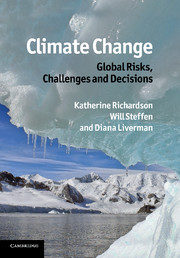Book contents
- Frontmatter
- Contents
- Writing team
- Foreword
- Preface
- List of acronyms and abbreviations
- Part I Climatic trends
- Part II Defining ‘dangerous climate change’
- Part III Equity issues
- Part IV Mitigation and adaptation approaches
- Part V Meeting the challenge
- 15 Integrating adaptation, mitigation and sustainable development
- 16 Mobilising the population
- 17 The human–Earth relationship: past, present and future
- Index
- Plate section
- References
17 - The human–Earth relationship: past, present and future
Published online by Cambridge University Press: 04 April 2011
- Frontmatter
- Contents
- Writing team
- Foreword
- Preface
- List of acronyms and abbreviations
- Part I Climatic trends
- Part II Defining ‘dangerous climate change’
- Part III Equity issues
- Part IV Mitigation and adaptation approaches
- Part V Meeting the challenge
- 15 Integrating adaptation, mitigation and sustainable development
- 16 Mobilising the population
- 17 The human–Earth relationship: past, present and future
- Index
- Plate section
- References
Summary
‘Nature takes no account of even the most reasonable of human excuses’
Introduction
Given that we humans are fundamentally dependent upon Earth and its natural resources for our very survival, we have always had – and will always have – an intimate relationship with the planet. The perception that different societies have had of this human–Earth relationship, however, has changed through time. In the first instance, it was addressed entirely through religion – the belief that (a) superpower(s) control(s) the destiny of the universe. Thus, it was accepted that it was the god(s) that controlled the seasons, rainfall, availability of food, and so on.
As scientific understanding has advanced and the number of humans and their activities have increased, both our perception and the nature of the human–Earth relationship have changed. A milestone in the evolution of this relationship was reached recently with the recognition that the Earth functions as a self-regulating system – where not only physical, chemical and biological, but also human processes interact to create the environmental conditions experienced (Moore et al., 2002). This new understanding of the human role in the functioning of the Earth System, itself, implies an obligation for active management of the human–Earth relationship at the global level.
Such management requires the development and use of new methods and approaches, both with respect to scientific study and the way in which we use science in policy decision-making.
- Type
- Chapter
- Information
- Climate Change: Global Risks, Challenges and Decisions , pp. 472 - 493Publisher: Cambridge University PressPrint publication year: 2011



